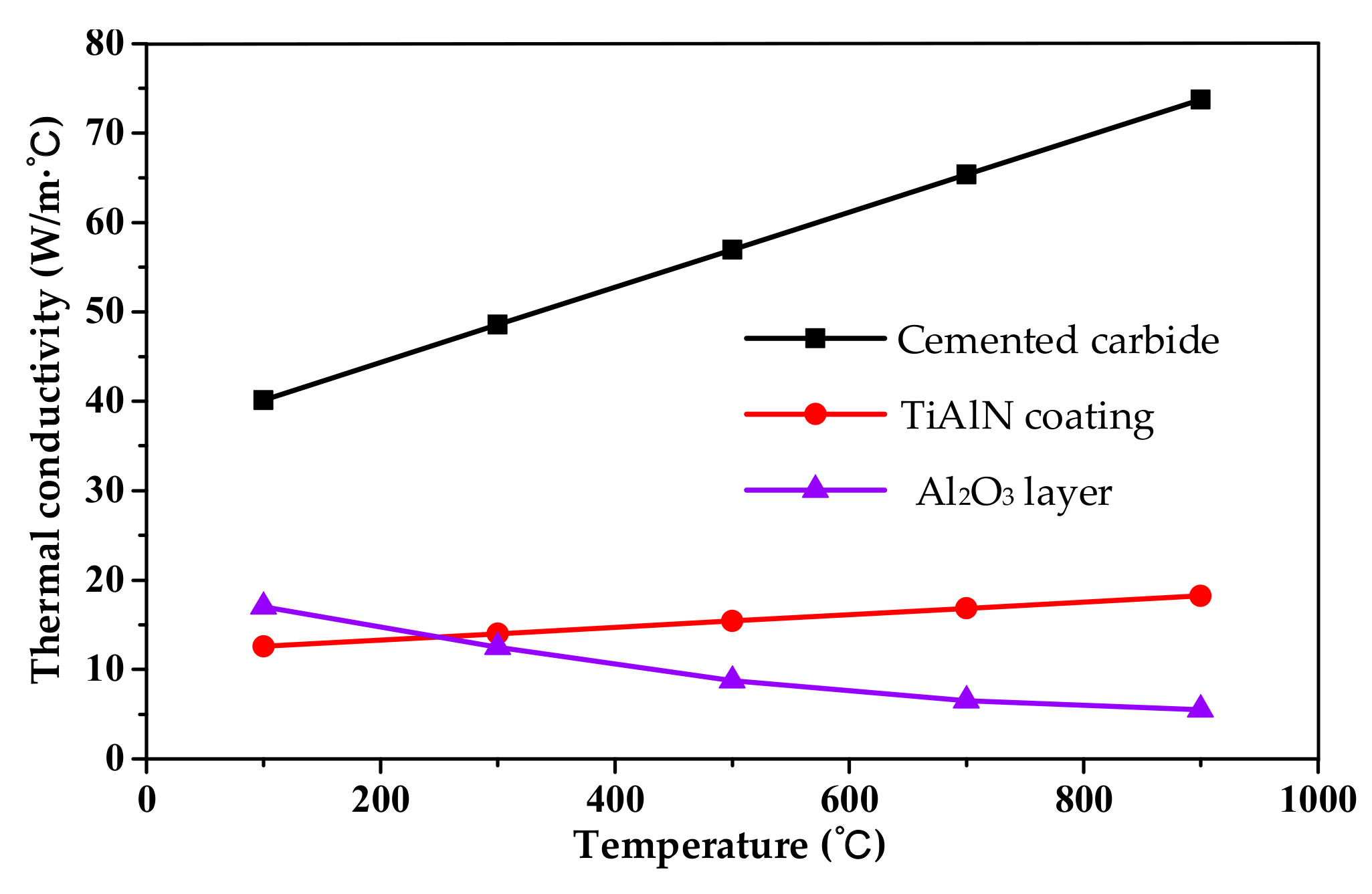Influences of TiAlN Coating on Cutting Temperature during Orthogonal Machining H13 Hardened Steel
Abstract
1. Introduction
2. Materials and Methods
2.1. Cutting Tools and Workpiece Material
2.2. Metal Cutting Experimental Techniques
2.3. Friction Tests under High Temperature
3. Results and Discussion
3.1. Influences of TiAlN Coating on Cutting Heat Generation
3.2. Influences of TiAlN Coating on Cutting Heat Conduction
3.3. Cutting Temperature
4. Conclusions
Author Contributions
Funding
Acknowledgments
Conflicts of Interest
References
- Chen, L.; Du, Y.; Mayrhofer, P.H.; Wang, S.Q.; Li, J. The influence of age-hardening on turning and milling performance of Ti–Al–N coated inserts. Surf. Coat. Technol. 2008, 202, 5158–5161. [Google Scholar] [CrossRef]
- Chen, L.; Du, Y.; Wang, S.Q.; Li, J. A comparative research on physical and mechanical properties of (Ti,Al)N and (Cr,Al)N PVD coatings with high Al content. Int. J. Refract. Met. Hard Mater. 2007, 25, 400–404. [Google Scholar] [CrossRef]
- Chen, L.; Moser, M.; Du, Y.; Mayrhofer, P.H. Compositional and structural evolution of sputtered Ti–Al–N. Thin Solid Films 2009, 517, 6635–6641. [Google Scholar] [CrossRef]
- Huang, L.; Chen, J.C.; Chang, T. Effect of tool/chip contact length on orthogonal turning performance. J. Ind. Technol. 1999, 15, 1–5. [Google Scholar]
- PalDey, S.; Deevi, S.C. Single layer and multilayer wear resistant coatings of (Ti, Al) N: A review. Mater. Sci. Eng. A 2003, 342, 58–79. [Google Scholar] [CrossRef]
- Rech, J.; Kusiak, A.; Battaglia, J.L. Tribological and thermal functions of cutting tool coatings. Surf. Coat. Technol. 2004, 186, 364–371. [Google Scholar] [CrossRef]
- Chen, L.; Paulitsch, J.; Du, Y.; Mayrhofer, P.H. Thermal stability and oxidation resistance of Ti–Al–N coatings. Surf. Coat. Technol. 2012, 206, 2954–2960. [Google Scholar] [CrossRef]
- Abukhshim, N.A.; Mativenga, P.T.; Sheikh, M.A. Heat generation and temperature prediction in metal cutting: A review and implications for high speed machining. Int. J. Mach. Tools Manuf. 2006, 46, 782–800. [Google Scholar] [CrossRef]
- Grzesik, W.; Rech, J.; Żak, K. Determination of friction in metal cutting with tool wear and flank face effects. Wear 2014, 317, 8–16. [Google Scholar] [CrossRef]
- Ozlu, E.; Budak, E.; Molinari, A. Analytical and experimental investigation of rake contact and friction behavior in metal cutting. Int. J. Mach. Tools Manuf. 2009, 49, 865–875. [Google Scholar] [CrossRef]
- Bahi, S.; Nouari, M.; Moufki, A.; El Mansori, M.; Molinari, A. Hybrid modelling of sliding-sticking zones at the tool-chip interface under dry machining and tool wear analysis. Wear 2012, 286, 45–54. [Google Scholar] [CrossRef]
- Rech, J. Influence of cutting tool coatings on the tribological phenomena at the tool-chip interface in orthogonal dry turning. Surf. Coat. Technol. 2006, 200, 5132–5139. [Google Scholar] [CrossRef]
- Balaji, A.K.; Mohan, V.S. An effective cutting tool thermal conductivity based model for tool-chip contact in machining with multi-layer coated cutting tools. Mach. Sci. Technol. 2002, 6, 415–436. [Google Scholar] [CrossRef]
- Grzesik, W.; Nieslony, P. A computational approach to evaluate temperature and heat partition in machining with multilayer coated tools. Int. J. Mach. Tools Manuf. 2003, 43, 1311–1317. [Google Scholar] [CrossRef]
- Fahad, M.; Mativenga, P.T.; Sheikh, M.A. Critical design factors for multi-layer coating systems that influence heat partition in the secondary shear deformation zone and machining performance. Proc. Inst. Mech. Eng. Part B J. Eng. Manuf. 2012, 226, 1071–1085. [Google Scholar] [CrossRef]
- Binder, M.; Klocke, F.; Doebbeler, B. Abrasive wear behavior under metal cutting conditions. Wear 2017, 376, 165–171. [Google Scholar] [CrossRef]
- Grzesik, W. Friction behaviour of heat isolating coatings in machining: Mechanical, thermal and energy-based considerations. Int. J. Mach. Tools Manuf. 2003, 43, 145–150. [Google Scholar] [CrossRef]
- Mo, J.L.; Zhu, M.H.; Lei, B.; Leng, Y.X.; Huang, N. Comparison of tribological behaviours of AlCrN and TiAlN coatings-Deposited by physical vapor deposition. Wear 2007, 263, 1423–1429. [Google Scholar] [CrossRef]
- Mo, J.L.; Zhu, M.H. Tribological oxidation behaviour of PVD hard coatings. Tribol. Int. 2009, 42, 1758–1764. [Google Scholar] [CrossRef]
- Liu, A.H.; Deng, J.X.; Cui, H.B.; Chen, Y.Y.; Zhao, J. Friction and wear properties of TiN, TiAlN, AlTiN and CrAlN PVD nitride coatings. Int. J. Refract. Met. Hard Mater. 2012, 31, 82–88. [Google Scholar] [CrossRef]
- Jiang, F.; Yan, L.; Rong, Y.M. Orthogonal cutting of hardened AISI D2 steel with TiAlN-coated inserts-simulations and experiments. Int. J. Adv. Manuf. Technol. 2013, 64, 1555–1563. [Google Scholar] [CrossRef]
- Friedman, M.Y.; Lenz, E. Investigation of the tool-chip contact length in metal cutting. Int. J. Mach. Tool Des. Res. 1970, 10, 401–416. [Google Scholar] [CrossRef]
- Balaji, A.K.; Sreeram, G.; Jawahir, I.S.; Lenz, E. The effects of cutting tool thermal conductivity on tool-chip contact length and cyclic chip formation in machining with grooved tools. CIRP Ann. Manuf. Technol. 1999, 48, 33–38. [Google Scholar] [CrossRef]
- Fahad, M.; Mativenga, P.T.; Sheikh, M.A. On the contribution of primary deformation zone-generated chip temperature to heat partition in machining. Int. J. Adv. Manuf. Technol. 2013, 68, 99–110. [Google Scholar] [CrossRef]
- Abukhshim, N.A.; Mativenga, P.T.; Sheikh, M.A. An investigation of the tool-chip contact length and wear in high-speed turning of EN19 steel. Proc. Inst. Mech. Eng. Part B J. Eng. Manuf. 2004, 218, 889–903. [Google Scholar] [CrossRef]
- Akbar, F.; Mativenga, P.T.; Sheikh, M.A. An evaluation of heat partition in the high-speed turning of AISI/SAE 4140 steel with uncoated and TiN-coated tools. Proc. Inst. Mech. Eng. Part B J. Eng. Manuf. 2008, 222, 759–771. [Google Scholar] [CrossRef]
- Akbar, F.; Mativenga, P.T.; Sheikh, M.A. On the heat partition properties of (Ti, Al) N compared with TiN coating in high-speed machining. Proc. Inst. Mech. Eng. Part B J. Eng. Manuf. 2009, 223, 363–375. [Google Scholar] [CrossRef]
- Akbar, F.; Mativenga, P.; Sheikh, M. Heat partition-based design of hard coatings in high-speed machining. Int. J. Mach. Mach. Mater. 2013, 14, 363–386. [Google Scholar] [CrossRef]
- Kong, D.J.; Guo, H.Y. Analysis of structure and bonding strength of AlTiN coatings by cathodic ion plating. Appl. Phys. A 2015, 119, 309–316. [Google Scholar] [CrossRef]
- Coelho, R.T.; Ng, E.G.; Elbestawi, M.A. Tool wear when turning hardened AISI 4340 with coated PCBN tools using finishing cutting conditions. Int. J. Mach. Tools Manuf. 2007, 47, 263–272. [Google Scholar] [CrossRef]
- Xu, Y.X.; Chen, L.; Yang, B.; Peng, Y.B.; Du, Y.; Feng, J.C.; Pei, F. Effect of CrN addition on the structure, mechanical and thermal properties of Ti–Al–N coating. Surf. Coat. Technol. 2013, 235, 506–512. [Google Scholar] [CrossRef]
- Chen, L.; Yang, B.; Xu, Y.X.; Pei, F.; Zhou, L.C.; Du, Y. Improved thermal stability and oxidation resistance of Al–Ti–N coating by Si addition. Thin Solid Films 2014, 556, 369–375. [Google Scholar] [CrossRef]
- Grzesik, W.; Bartoszuk, M.; Nieslony, P. Finite difference analysis of the thermal behaviour of coated tools in orthogonal cutting of steels. Int. J. Mach. Tools Manuf. 2004, 44, 1451–1462. [Google Scholar] [CrossRef]
- Koneshlou, M.; Asl, K.M.; Khomamizadeh, F. Effect of cryogenic treatment on microstructure, mechanical and wear behaviors of AISI H13 hot work tool steel. Cryogenics 2011, 51, 55–61. [Google Scholar] [CrossRef]
- Ng, E.G.; Aspinwall, D.K.; Brazil, D.; Monaghan, J. Modelling of temperature and forces when orthogonally machining hardened steel. Int. J. Mach. Tools Manuf. 1999, 39, 885–903. [Google Scholar] [CrossRef]
- Fahad, M.; Mativenga, P.T.; Sheikh, M.A. An investigation of multilayer coated (TiCN/Al2O3-TiN) tungsten carbide tools in high speed cutting using a hybrid finite element and experimental technique. Proc. Inst. Mech. Eng. Part B J. Eng. Manuf. 2011, 225, 1835–1850. [Google Scholar] [CrossRef]
- Jindal, P.C.; Santhanam, A.T.; Schleinkofer, U.; Shuster, A.F. Performance of PVD TiN, TiCN, and TiAlN coated cemented carbide tools in turning. Int. J. Refract. Met. Hard Mater. 1999, 17, 163–170. [Google Scholar] [CrossRef]
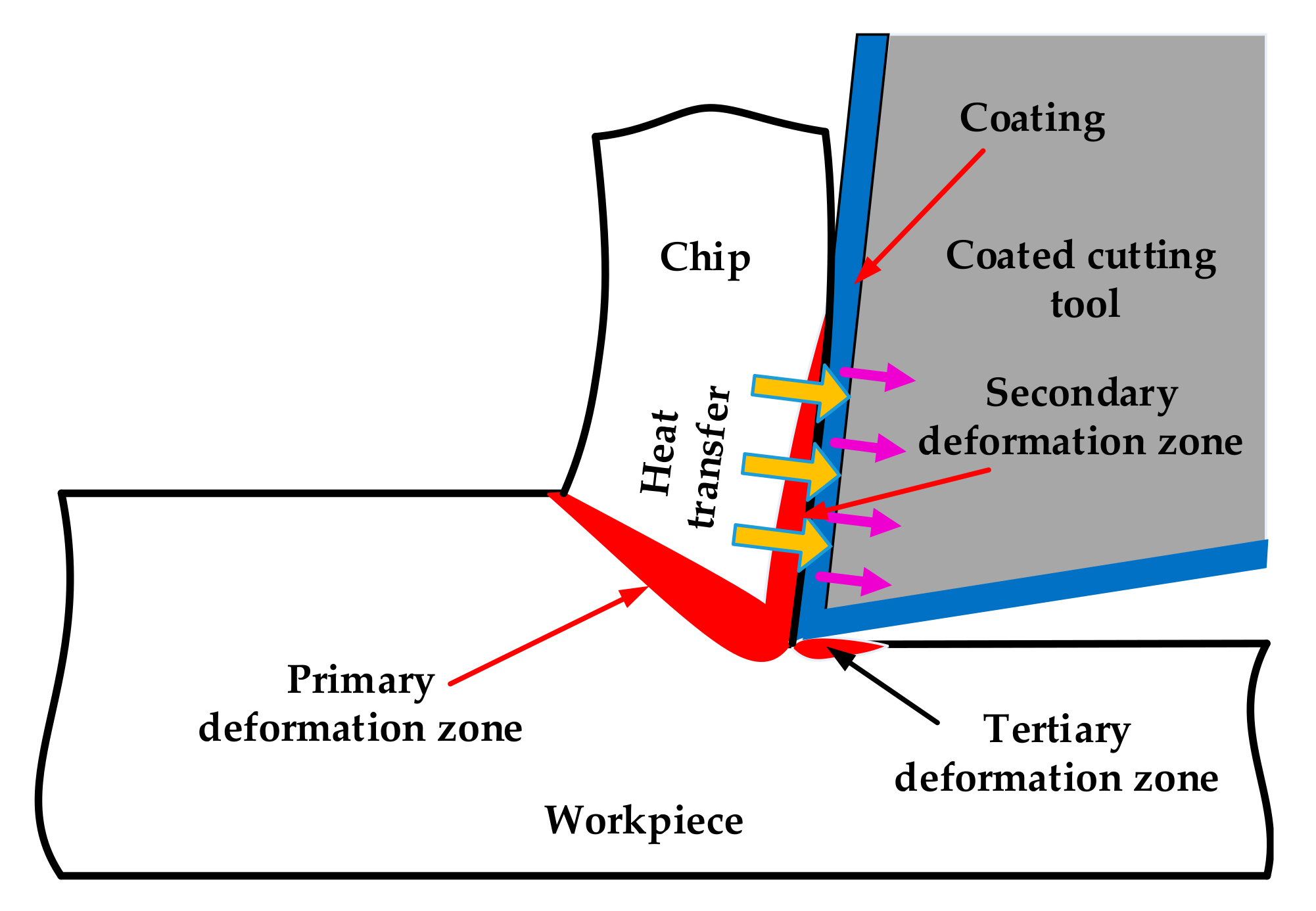
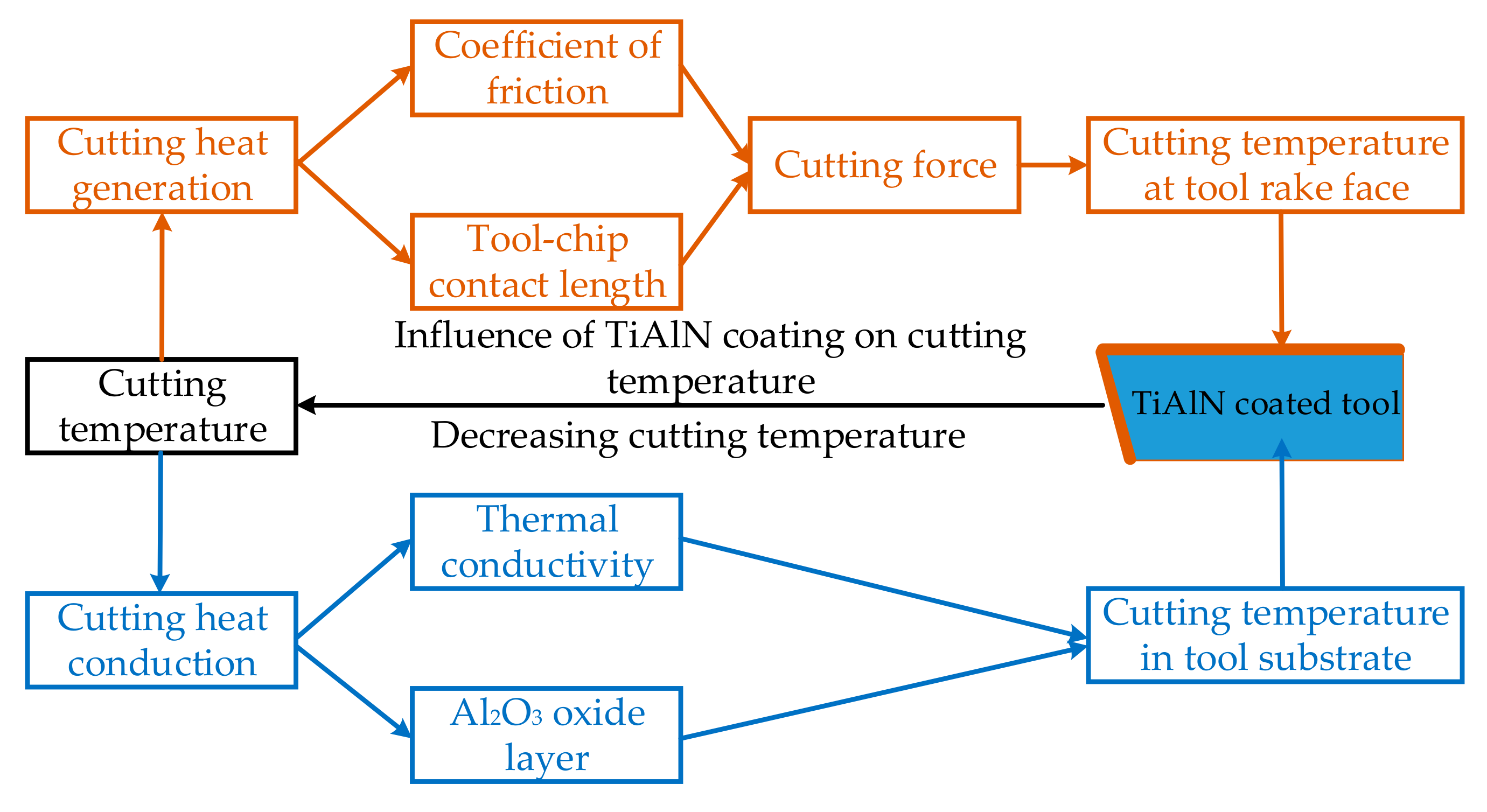
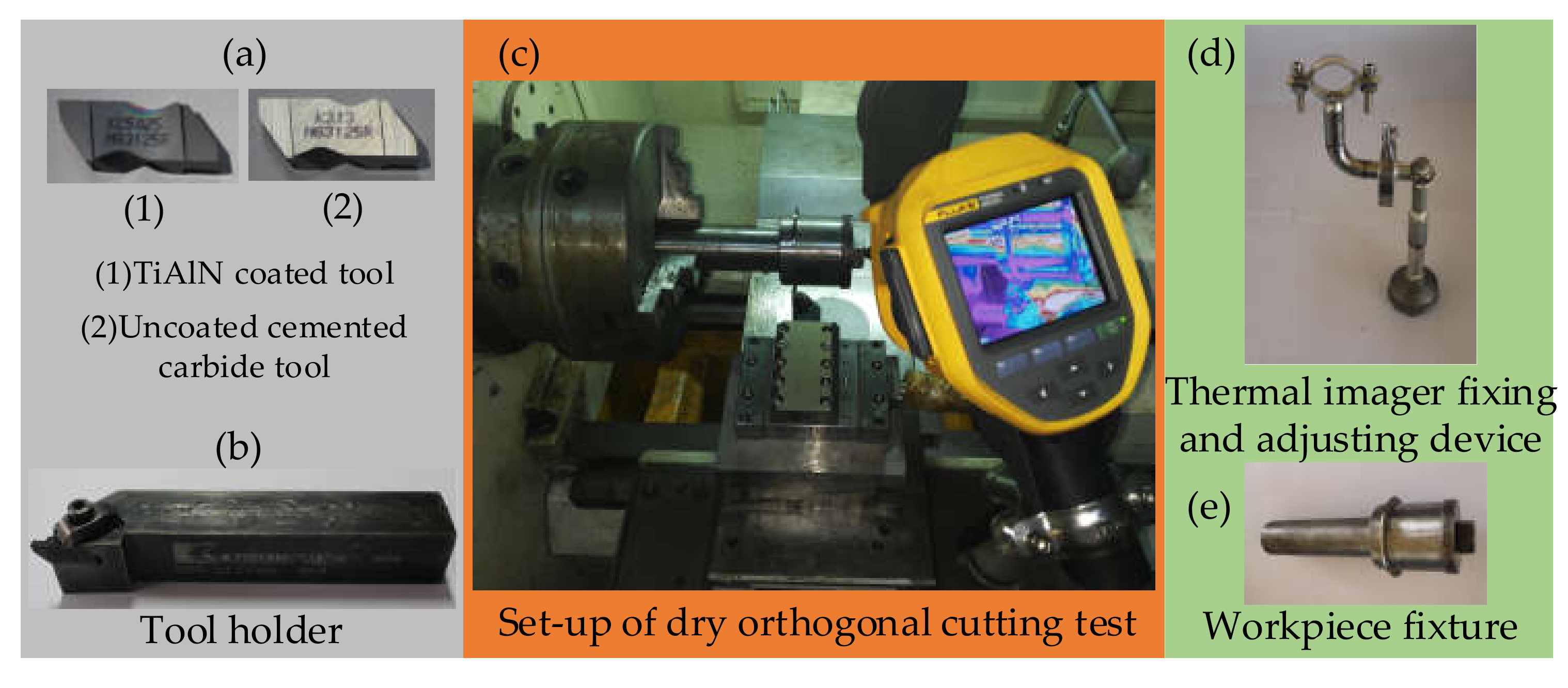
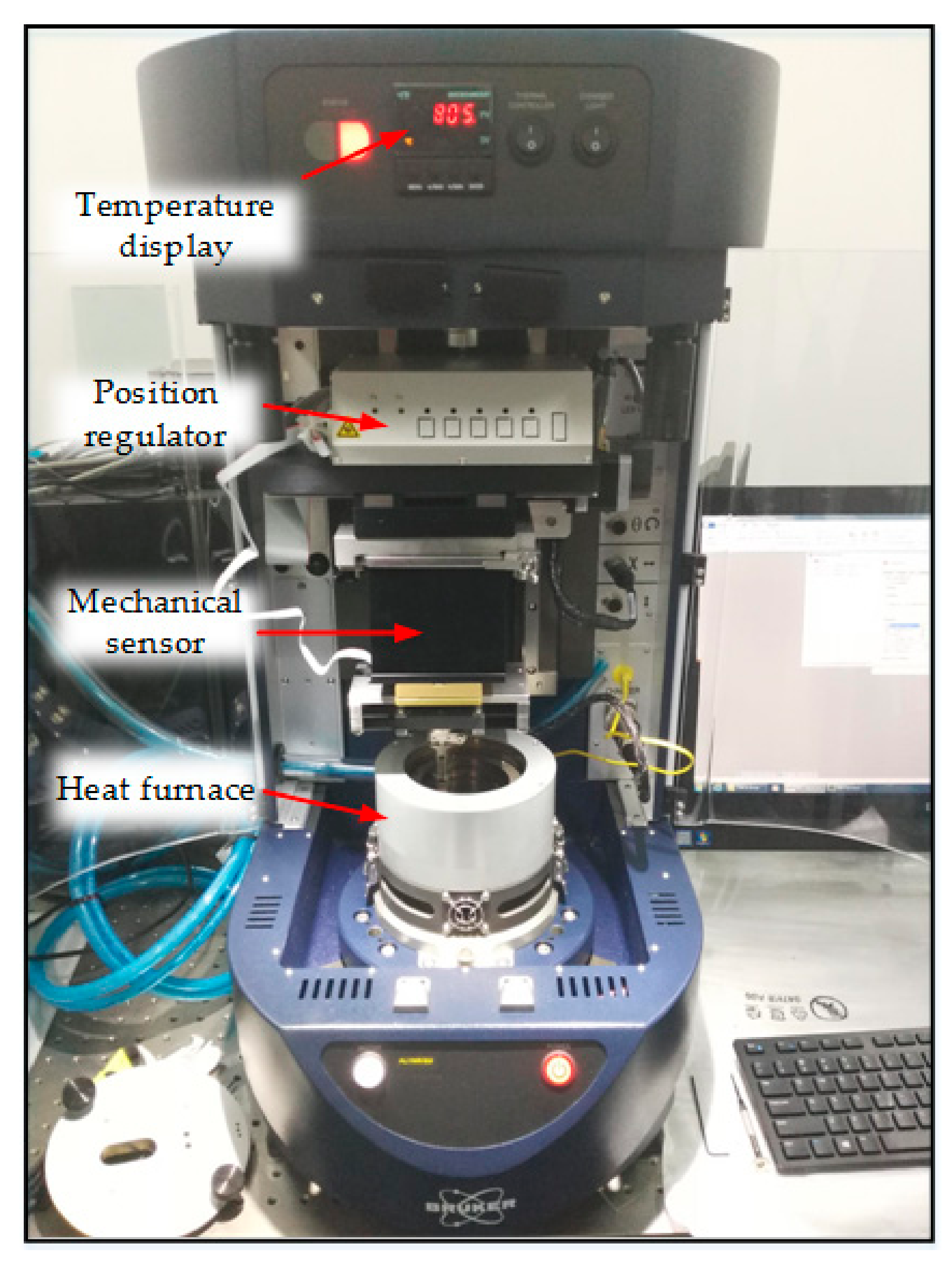
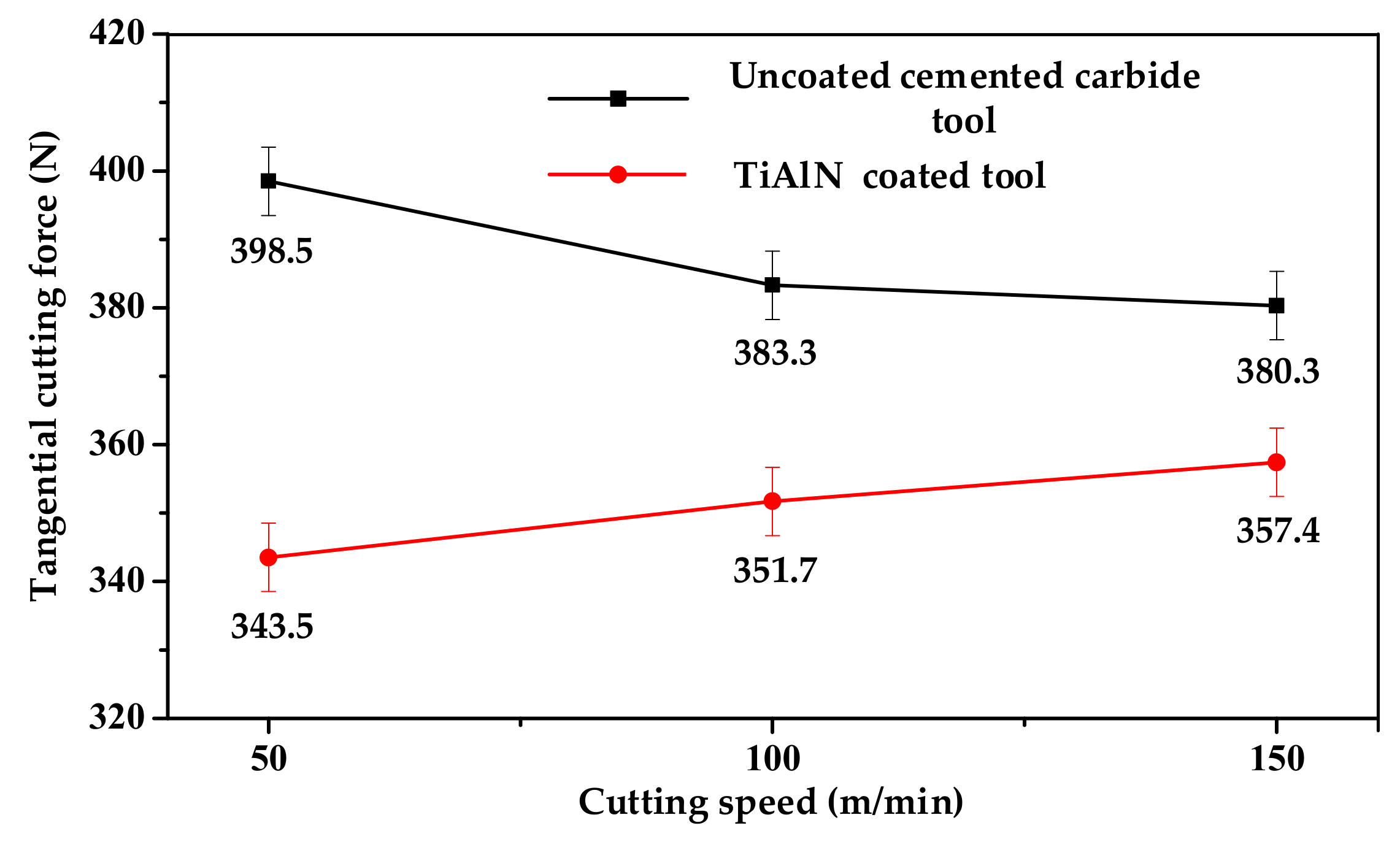
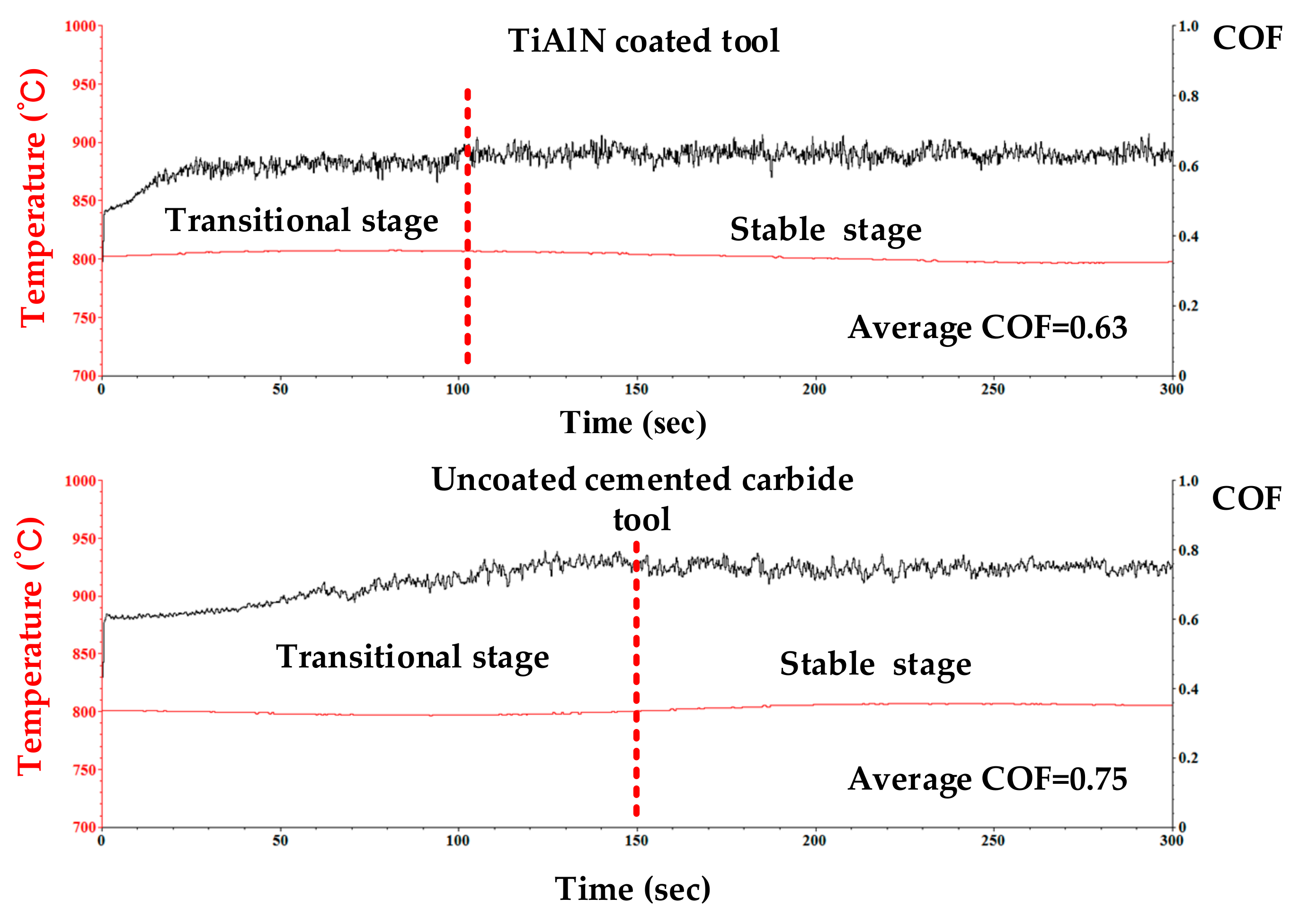
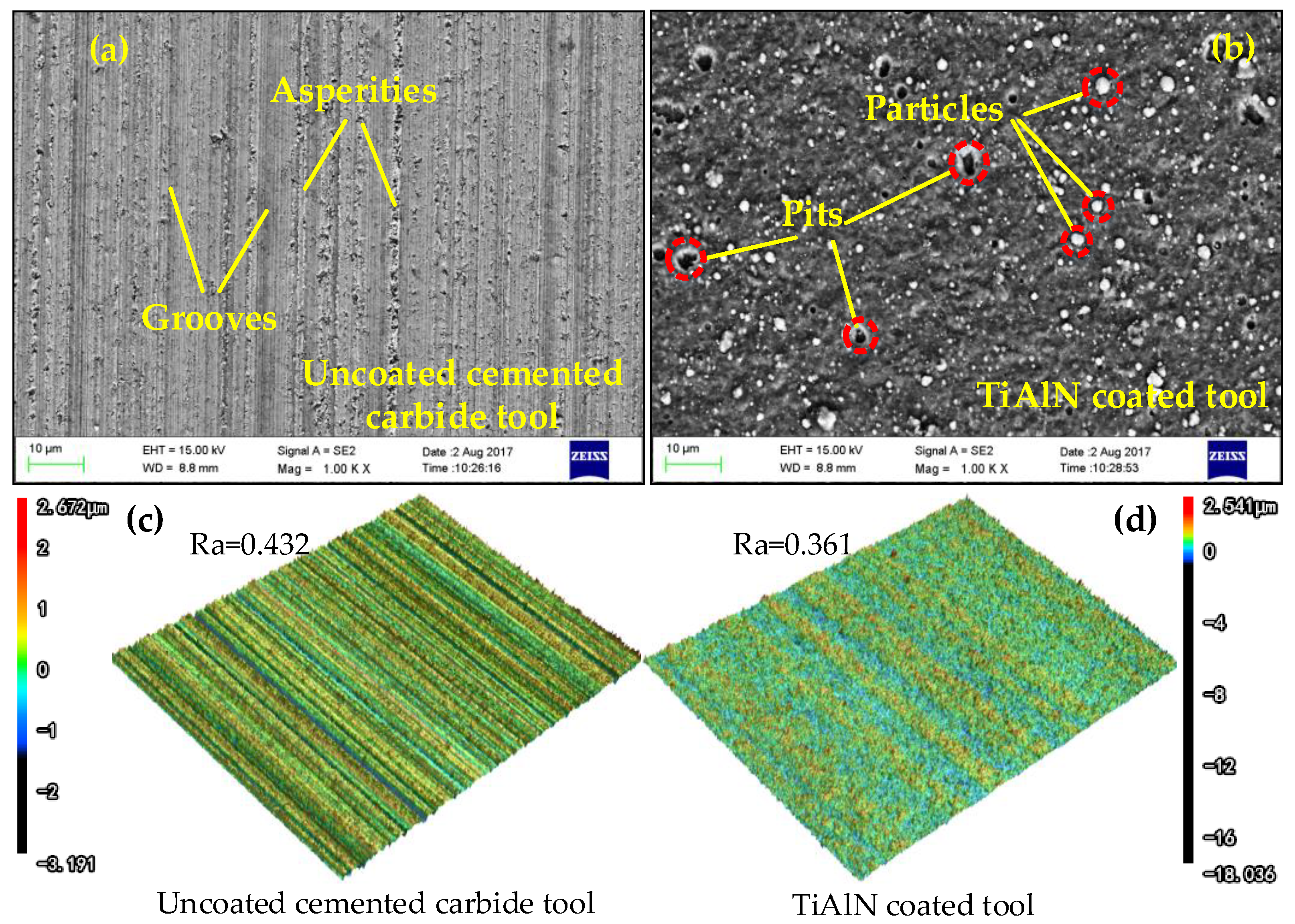

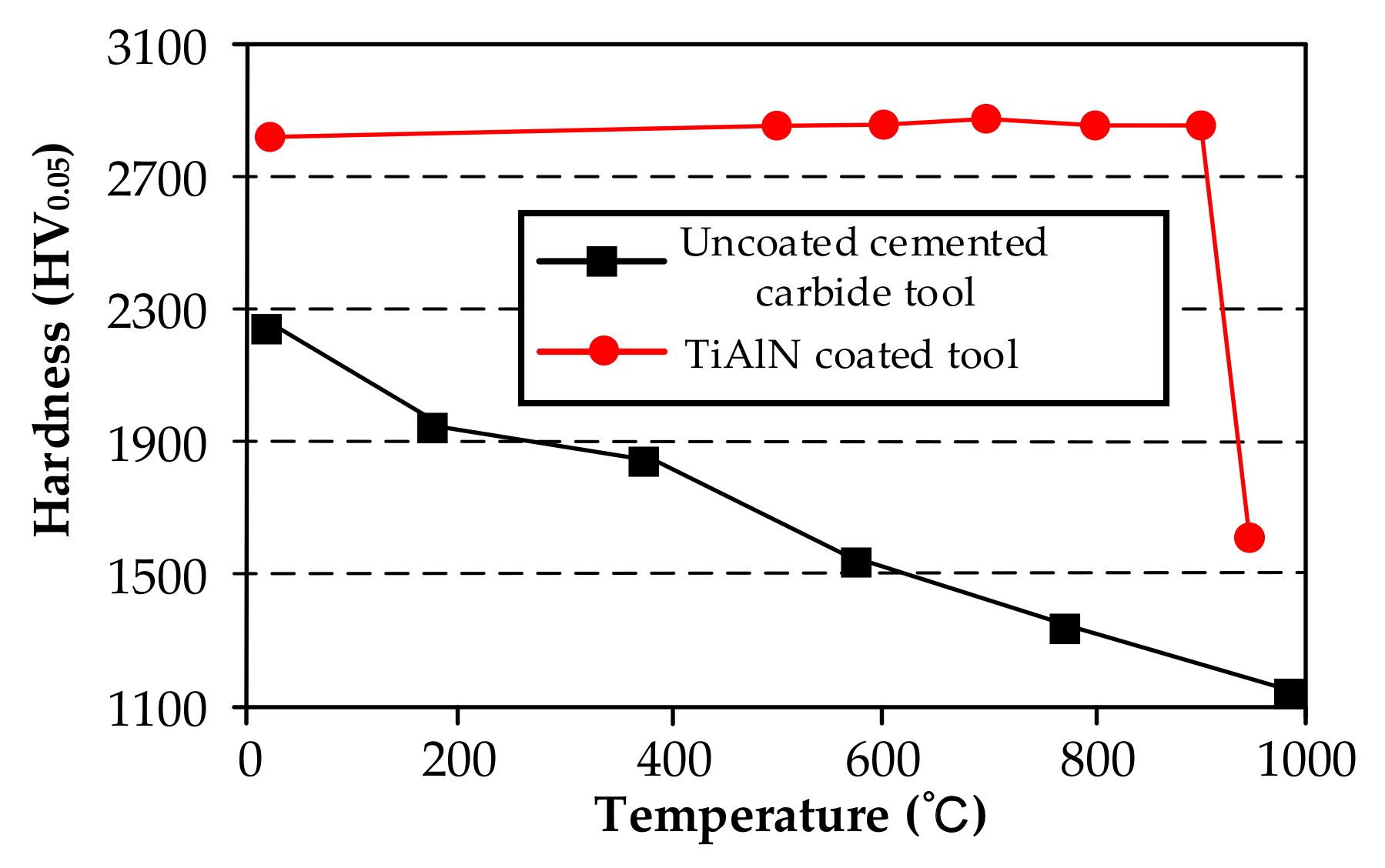
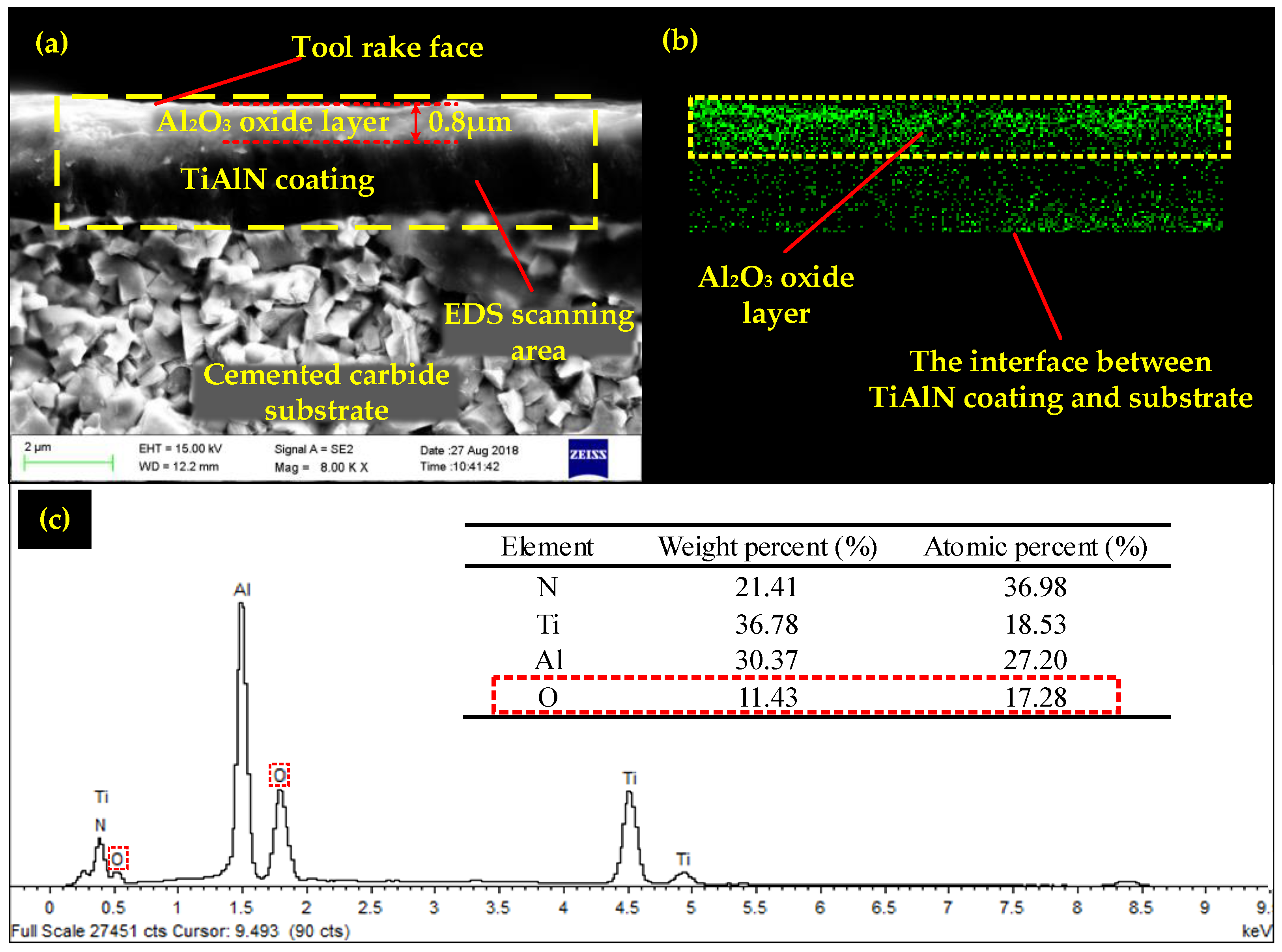
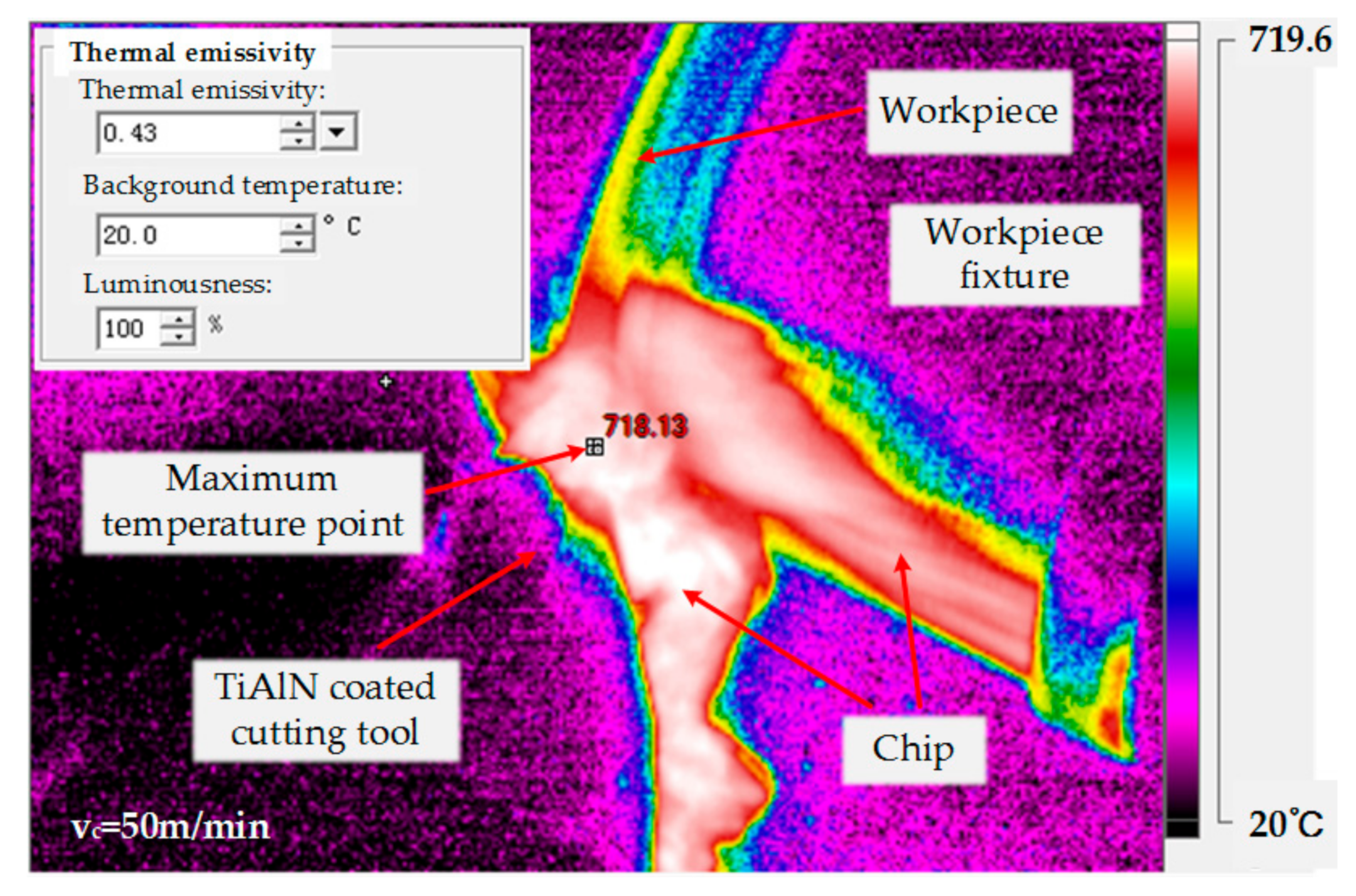
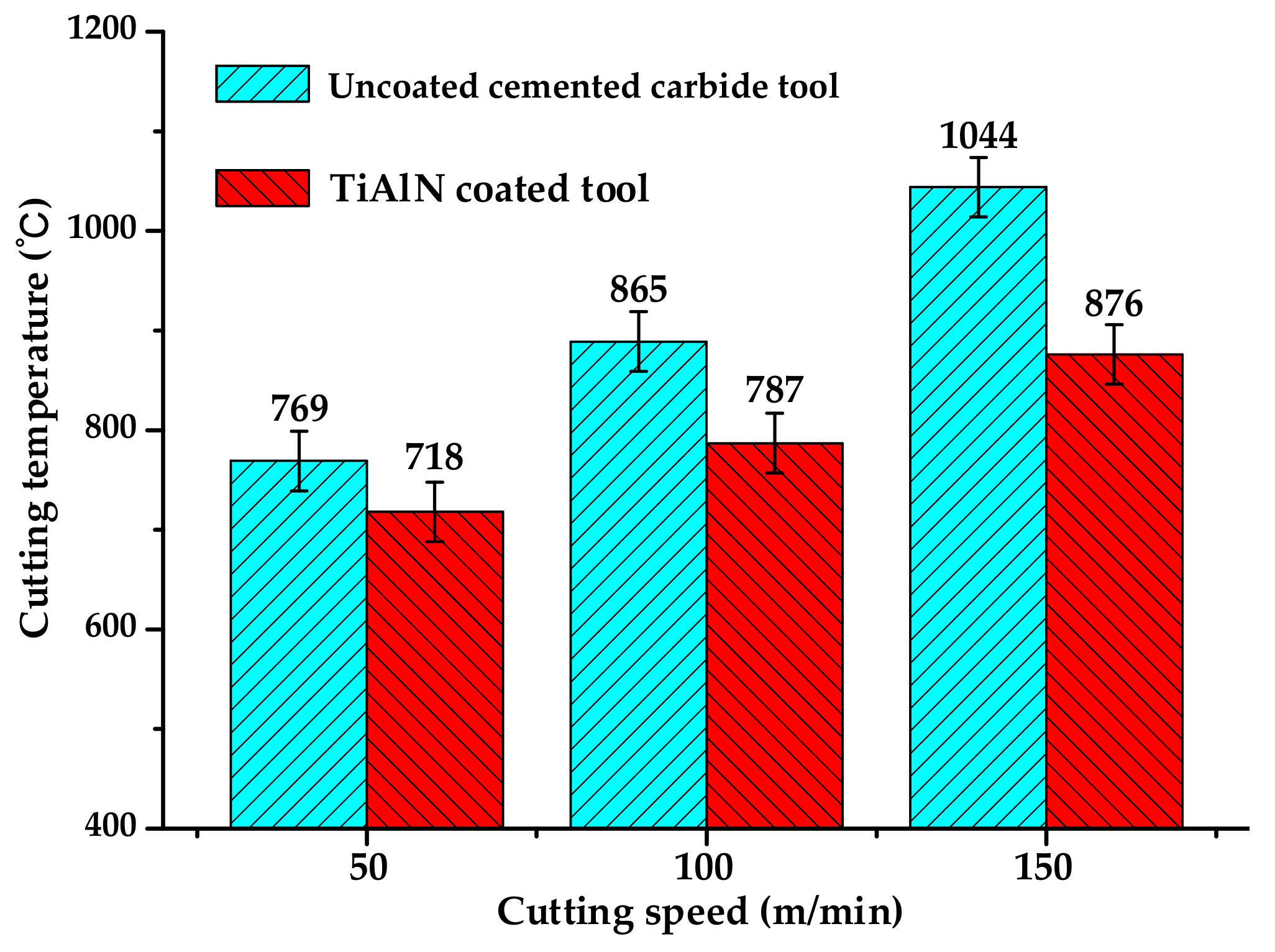
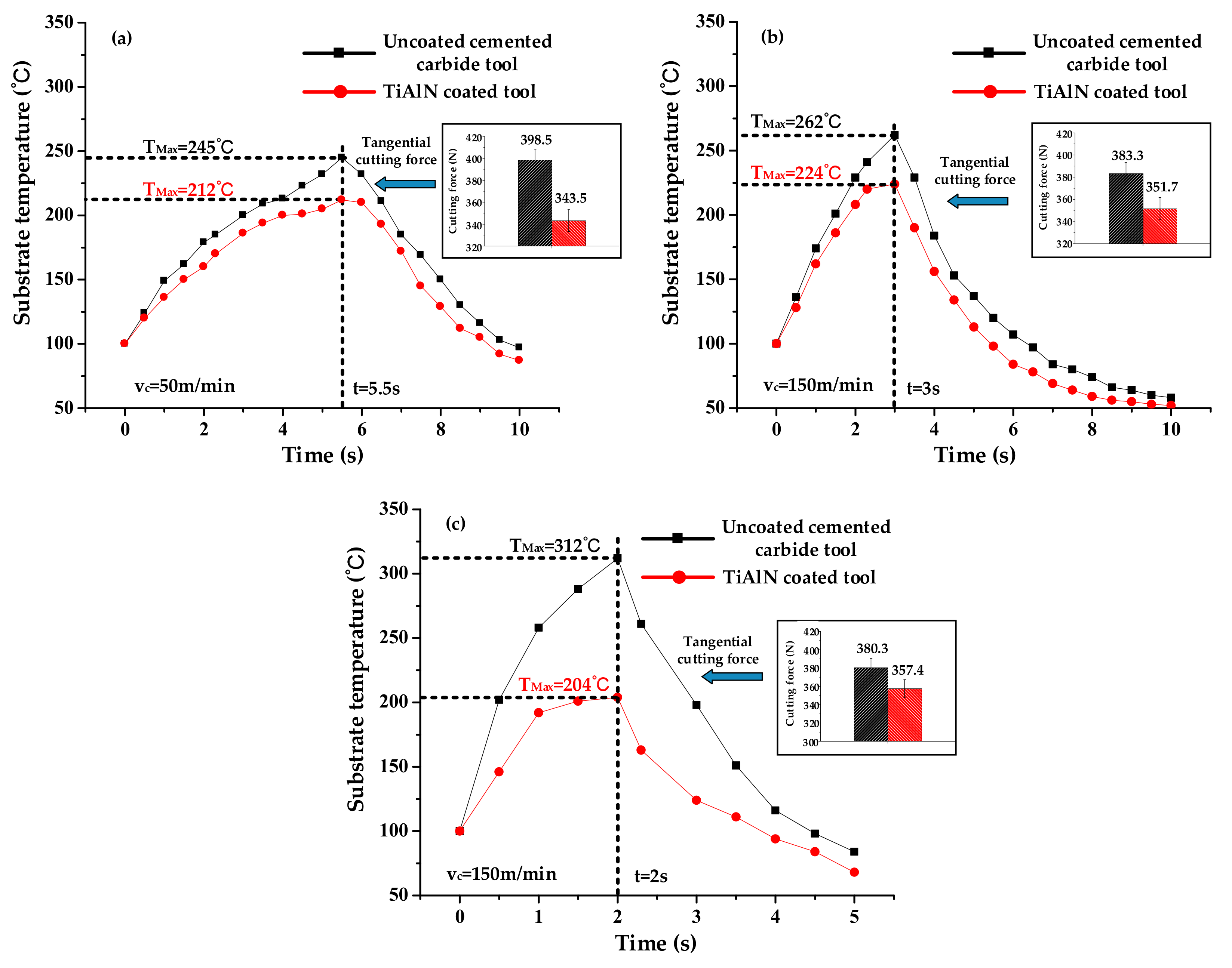
| Composition | C | Si | Mn | Cr | Mo | V | Fe |
|---|---|---|---|---|---|---|---|
| (wt) % | 0.32–0.45 | 0.80–1.20 | 0.20–0.50 | 4.75–5.50 | 1.10–1.75 | 0.80–1.20 | Balance |
| Properties | Young’s Modulus (GN/m2) | Poisson Ratio | Density (kg/m3) | Thermal Conductivity (W/m·°C) | Specific Heat Capacity (J/kg·°C) | Shear Flow Stress (MN/m2) | Hardness (HV) |
|---|---|---|---|---|---|---|---|
| Value | 211 | 0.28 | 7800 | 37 | 560 | 1033 | 544 |
© 2019 by the authors. Licensee MDPI, Basel, Switzerland. This article is an open access article distributed under the terms and conditions of the Creative Commons Attribution (CC BY) license (http://creativecommons.org/licenses/by/4.0/).
Share and Cite
Hao, G.; Liu, Z.; Liang, X.; Zhao, J. Influences of TiAlN Coating on Cutting Temperature during Orthogonal Machining H13 Hardened Steel. Coatings 2019, 9, 355. https://doi.org/10.3390/coatings9060355
Hao G, Liu Z, Liang X, Zhao J. Influences of TiAlN Coating on Cutting Temperature during Orthogonal Machining H13 Hardened Steel. Coatings. 2019; 9(6):355. https://doi.org/10.3390/coatings9060355
Chicago/Turabian StyleHao, Guangchao, Zhanqiang Liu, Xiaoliang Liang, and Jinfu Zhao. 2019. "Influences of TiAlN Coating on Cutting Temperature during Orthogonal Machining H13 Hardened Steel" Coatings 9, no. 6: 355. https://doi.org/10.3390/coatings9060355
APA StyleHao, G., Liu, Z., Liang, X., & Zhao, J. (2019). Influences of TiAlN Coating on Cutting Temperature during Orthogonal Machining H13 Hardened Steel. Coatings, 9(6), 355. https://doi.org/10.3390/coatings9060355






